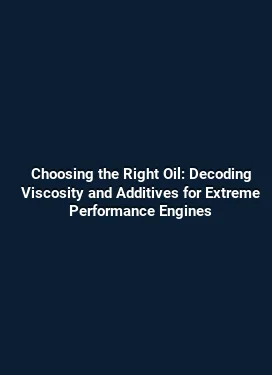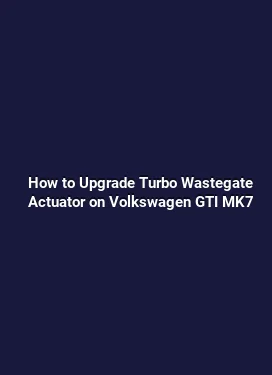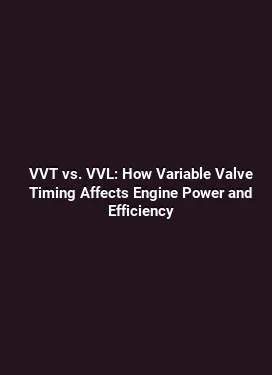Cylinder Head Porting and Polishing: The ROI on Airflow Improvements
Key Principles Behind Porting and Polishing for Engine Performance

Porting and polishing of the cylinder head is a precision practice aimed at reducing flow resistance and shaping the path that air and fuel take as they enter the combustion chamber. While a strong aftermarket exhaust and a tuning strategy can complement power gains, the most impactful gains often originate from how efficiently air can move through the intake ports and past the valves. The process involves removing casting flaws, refining port contours, blending transitions, and smoothing surfaces without weakening structural integrity. By understanding the physics of flow, engine designers and performance enthusiasts can target improvements that translate into real-world performance benefits such as quicker throttle response, improved peak torque, and more consistent power delivery across RPM ranges.
In practical terms, airflow enhancement is not about chasing the largest opening or the wildest port shape. It is about balancing port cross-sectional area with velocity and maintaining favorable flow characteristics through the valve seats and into the combustion chamber. A well-executed porting job reduces boundary layer separation, minimizes turbulence at critical cross-sections, and preserves or improves swirl and tumble patterns that promote efficient mixing of air and fuel. The result is not merely horsepower figures but a more linear, repeatable, and tractable engine response that can be tuned to different customer goals, whether tracking measurable power gains on a dyno or delivering stronger mid-range torque for street driving.
ROI: How Airflow Gains Translate to Real-World Performance
Return on investment in cylinder head work hinges on several interconnected factors. First, the baseline engine architecture matters: factory ports may be optimized for broad, street-friendly behavior but leave room for improvement in specific operating windows, such as mid-range torque or high-RPM breathing. Second, the intended application sets the target: a naturally aspirated build will respond differently to porting than a boosted configuration, where improvements in volumetric efficiency and air velocity can reduce compressor work and improve spool characteristics. Third, the quality of the porting and polishing process determines whether gains are incremental or transformative. A meticulous approach—carefully removing material only where it improves flow, maintaining exact valve seat geometry, and preserving gasket and coolant passages—tends to deliver reliable, repeatable results rather than ephemeral, peak-only gains.
From the data perspective, a well-executed porting job can yield a noticeable rise in volumetric efficiency, especially at the RPM ranges where the engine spends most of its time. Even modest improvements in air velocity through the ports can translate to higher air mass flow into the cylinder, enabling a richer air-fuel mixture and a more favorable ignition window. In practice, this often means stronger torque in the midrange, sharper throttle response, and improved engine breathing at higher RPMs. The ROI is not solely measured in horsepower; it is reflected in the engine’s ability to sustain power without excessive throttle opening, reduced surge risk at part throttle, and heightened predictability in performance tuning.
Assessing Current Flow Characteristics Before You Start

Before any material is removed, a systematic assessment establishes the starting point. A flow bench test, even in a modest workshop setup, yields invaluable data about valve pocket flow, bench pressure drop, and flow coefficient across different lift profiles. Observing the baseline helps identify choke points: restricted runner sections, sharp corners, valve guide interference, or rough transitions between the port walls and the valve seat. Mapping these signatures guides the porting strategy—prioritizing areas where smoothing and blending will deliver the most meaningful gains. In some cases, port shapes with mild undercuts or refined radii near the valve seats can deliver a higher flow coefficient without risking detonation sensitivity or structural concerns.
Material Realities: Casting, Steel, and Aluminum Porting Nuances
The material makeup of the cylinder head influences both the approach and the final outcome of porting. Aluminum heads, prized for their lightness and excellent thermal characteristics, respond well to careful material removal, provided cooling passages and valve seats remain within safe tolerances. Iron or steel heads, while typically more rigid, require more conservative material removal to avoid compromising structural integrity and valve seating geometry. In all cases, the goal is to produce a smooth transition from the port entrance to the valve seat, striking a balance between larger flow area and the maintenance of adequate airspeed, especially at lower RPMs where velocity plays a critical role in tumble and swirl formation.
When porting aluminum heads, technicians often leverage abrasive tools that can maintain consistent material removal and minimize heat buildup, preserving the temper and dimensional stability of the port walls. For cast iron, the emphasis shifts toward precision grinding and careful edge refinement to avoid microcracks and to safeguard gasket sealing surfaces. In both materials, the finishing stage—polishing or satin-smoothing of the port walls—reduces frictional losses and helps sustain laminar flow across a wider range of lifts, which translates into steadier power delivery and more predictable engine behavior.
Blending, The Fine Art: From Rough to Ready
Blending is the process of smoothing abrupt transitions between the port walls and the valve seat, as well as shaping radii around bends in the runners. The aim is not to create a perfectly smooth bore at all costs but to minimize sudden changes in cross-section that can trigger turbulence and flow separation. The most effective blends maintain the original valve geometry and seat angle, ensuring that the port still seals correctly with the gasket. A conservative blending approach near the valve seat can improve flow by reducing micro-turbulence while preserving seat integrity and sealing reliability. The blend length, radius, and surface finish must be chosen with the engine’s static and dynamic compression ratio in mind, along with the eventual cam timing and intake manifold design.
Polishing: To Polish or Not to Polish, That Is the Question
Polishing ports to a mirror finish may be beneficial in some scenarios, but it is not a universal solution. The objective is to reduce roughness and boundary layer effects without eliminating the natural turbulence that aids fuel-air mixing at certain rpm bands. A carefully chosen satin or fine-textured finish often yields the best balance between low friction and productive mixing, particularly in engines that rely on port geometry to enhance swirl and tumble patterns. Over-polished ports can inadvertently raise the risk of flashback or fuel separation in certain conditions, especially in boosted engines with dynamic pressure changes. Therefore, the finishing strategy should be aligned with the engine’s overall breathing system, including intake tract length, throttle body size, and the presence (or absence) of aftermarket forced induction.
Impact on Airflow Kinetics: Velocity, Pressure, and Flow Coefficients
Understanding the kinetic side of airflow helps explain why porting and polishing can shift an engine’s performance envelope. Enhancing the cross-sectional area of a port increases the potential air mass that can reach the chamber, but it can also reduce airspeed if done excessively. The key is to maintain or improve velocity at the valve seat and throat, where the boundary layer exerts the strongest influence on charge filling. Engineers often monitor flow coefficients at multiple lift points to ensure that the improvements hold across the engine’s operating range. This multi-point analysis helps avoid situations where gains at peak lift come at the expense of part-throttle throughput, which would undermine everyday drivability.
Compatibility with Other Performance Modifications
Porting and polishing works best when considered as part of an integrated performance plan. A higher-flow head pairs with appropriately matched camshafts, optimized intake manifolds, and calibrated fueling strategies. In naturally aspirated builds, cam timing and valve lift become especially relevant; the porting effort should support the engine’s intended breathing window rather than simply chasing peak figures. For forced-induction setups, the improved intake path can reduce compressor work and improve charge density, but it must be balanced with intercooling, fuel delivery, and ignition timing to prevent detonation and maintain reliability. The most successful projects treat airflow improvements as one part of a holistic approach to engine efficiency, not a standalone upgrade.
Case Studies: Real-World Gains and Practical Observations
In a documented example, a mid-displacement naturally aspirated engine undergoing head work achieved a noticeable torque increase in the 4000–5500 RPM band, accompanied by a morelinear throttle response. The dyno graph showed an expanded power curve with a smoother rise rather than a sharp spike, which is often more valuable for street-driven vehicles than final peak horsepower alone. In another case, a boosted setup benefited from improved port velocity that reduced intake manifold pressure pulsations at high boost levels. The result was a more stable engine response under load, reducing throttle ambiguity during cornering or aggressive downshifts. These outcomes illustrate that ROI extends beyond the numbers on a chart; it also encompasses drivability, predictability, and driver confidence under dynamic conditions.
Process Workflow: From Measurement to Finish
Executing cylinder head work with consistent results requires a disciplined workflow. The typical sequence starts with baseline measurement, including inspection of valve seats, guides, springs, and overall sealing integrity. Next comes 3D mapping of port contours, using digital scanners or careful manual profiling to identify high-priority smoothing zones. The removal phase proceeds in small, measured increments guided by flow targets and geometry constraints. Intermediate flow tests confirm whether changes are moving in the desired direction before proceeding. The finishing stage includes careful deburring, final surface texture refinement, and a leak-tested assembly to verify sealing and cooling passages. Documentation of all measurements and decisions helps reproduce results on subsequent builds or when tailoring the work to different engine configurations.
Quality, Safety, and Reliability Considerations
The porting and polishing process must preserve structural integrity and maintain reliable sealing surfaces. Excessive material removal near valve seats can lead to improper valve seating, leakage, or valve recession under dynamic loads. Proper heat management remains essential; porting can slightly alter cooling flow patterns, so recalibration of cooling channels and gaskets may be appropriate. Case-by-case assessment ensures that safety margins are respected, especially in high-revving or high-boost applications where small geometry changes can have amplified effects on reliability. A conservative, measured approach paired with thorough testing often yields the most dependable ROI over the long term.
Technologies and Tools That Support Better Outcomes
Modern porting projects benefit from a mix of traditional handwork and advanced tooling. Precision grinders, carbide burrs, and high-quality abrasives provide controlled material removal. Shadow-projection or 3D scanning enables accurate replication of preferred shapes while avoiding guesswork. Flow benches and dynamometer testing remain essential for verifying improvements and calibrating subsequent tuning steps. While these tools do not replace skill and experience, they enable craftsmen to iterate with greater confidence, reducing the risk of over- or under-enhancement and delivering results that are both measurable and meaningful for diverse driving scenarios.
Maintenance Implications After Porting
Following porting, routine maintenance gains added importance. Combustion chamber cleanliness, fuel quality, and compression stability all influence how effectively the improved breathing translates into real-world performance. Regular inspection of valve seats, seals, and intake tract components helps maintain peak efficiency and prevents performance degradation caused by debris, gasket leaks, or carbon buildup. It is also prudent to monitor engine temperature and ignition timing, as these factors can interact with the altered breathing characteristics to affect efficiency and reliability over time.
Conclusion: A Performance Investment With Measurable Returns
Porting and polishing the cylinder head can be a strategically sound investment when aligned with the engine’s architecture, intended use, and supporting components. The ROI is realized through stronger mid-range torque, improved throttle response, and more consistent power delivery across RPMs. By approaching the work with disciplined measurement, careful material removal, and a finishing strategy tailored to the specific application, enthusiasts and professionals can achieve meaningful, lasting gains without compromising reliability. The result is an engine that breathes more efficiently, responds more crisply to driver input, and delivers a more engaging driving experience across varied conditions.






